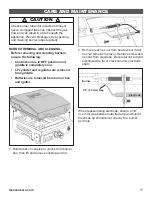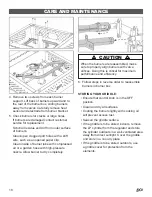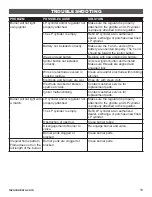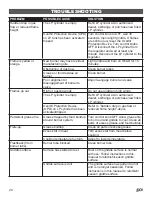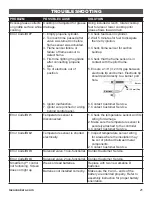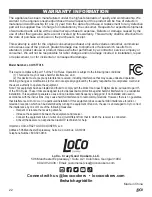
12
LP CYLINDER REMOVAL, TRANSPORT AND
STORAGE
1. Turn control knob OFF. Unscrew regulator
collar from griddle, then unscrew LP cylinder
from regulator.
2. Place dust cap on cylinder valve outlet
whenever the cylinder is not in use. Only
install the type of dust cap on the cylinder
valve outlet that is provided with the cylinder
valve. Other types of caps or plugs may
result in leakage of propane.
3. A disconnected LP cylinder in storage or
being transported must have a safety cap
installed.
4. The cylinder must be stored outdoors out
of reach of children. NEVER store the
cylinder in enclosed spaces such as a
garage, carport, covered porch or any other
structure.
5. When the appliance is not in use, the gas
must be turned o
ff
at the control knob.
6. Storage of an appliance indoors is
permissible only if the cylinder is
disconnected and removed from the
appliance.
7. The cylinder must be disconnected when
the appliance is not in use.
LP GAS CYLINDER
LEAK TESTING:
• A leak test is recommended before each
use and must be repeated each time LP
cylinder is exchanged or re
fi
lled.
• DO NOT smoke or have anything nearby
that can easily ignite, such as lighters or
matches.
• DO NOT use an open
fl
ame to check for
gas leaks.
• Appliance must be leak tested outdoors in a
well-ventilated area away from open
fl
ames
or sparks.
STEPS TO LEAK TEST:
1. Use a clean paintbrush and 50/50 soap and
water solution. Use mild soap and water.
DO NOT use household cleaning agents.
Damage to gas train components could
result.
2. Brush soapy solution onto the shaded
areas in the illustration below. At the
fi
rst
sign of bubbles around the connections,
immediately disconnect.
3. If bubbles are observed, you may attempt to
tighten the connections and repeat the test
from the beginning after waiting 5 minutes.
If “growing” bubbles appear, there is a
leak. Close LP tank valve immediately and
retighten connections. If leaks cannot be
stopped, do not try to repair. IMMEDIATELY
turn o
ff
LP tank valve. If bubbles continue,
IMMEDIATELY get away from the LP tank
and contact your FIRE DEPARTMENT (911).
WARNING

















